Data Sources for Organizational Network Analysis
Boost your ONA with reliable data sources for organization network analysis. Explore both active and passive insights. Unlock full potential today!
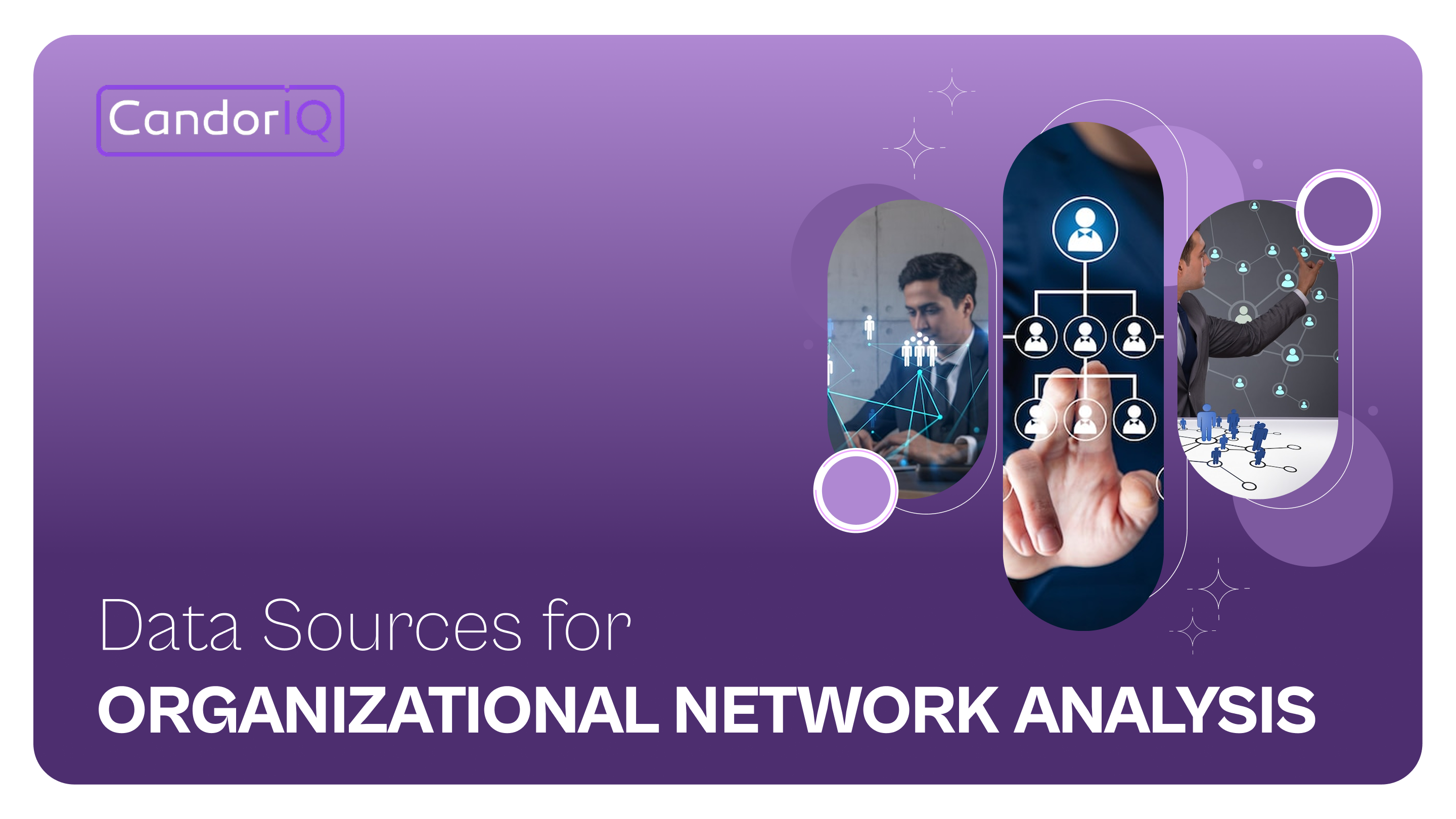
As companies grow quickly, understanding how employees collaborate becomes essential to long-term success. It’s easy to fall into the trap of tracking metrics like hours worked or emails sent to gauge productivity. However, these numbers don’t reflect how teams truly collaborate and achieve results together.
Studies show that 60% of executives focus on these basic productivity measures, missing out on the deeper insights that truly matter. These metrics overlook the vital relationships and communication patterns that drive a company’s success. To improve productivity and engagement, it’s crucial to understand how employees are working together, not just how much they’re working.
In this blog, we’ll explore how Organizational Network Analysis (ONA) can offer valuable insights into communication and collaboration. ONA helps fast-growing companies in the USA that are scaling rapidly to enhance employee engagement, boost productivity, and make more informed decisions.
Key Takeaways
- ONA reveals how employees interact and collaborate, helping organizations optimize team dynamics and improve overall performance.
- Combining active and passive data sources provides a complete view of communication patterns, enhancing decision-making.
- Active data, such as surveys, provides direct insights into employee relationships and satisfaction, thereby adding context to passive data.
- Passive data from communication tools, emails, and calendars offers real-time insights into collaboration and workflow efficiency.
- Platforms like CandorIQ can integrate ONA with compensation and headcount planning, ensuring better alignment and reducing miscommunication risks.
What is Organizational Network Analysis (ONA)?
Organizational Network Analysis (ONA) studies the relationships within an organization. It maps how employees communicate, collaborate, and share information, revealing both formal and informal networks. ONA is particularly valuable for mid-sized to growth-stage companies with lean HR and finance teams, especially those scaling headcount by 2–3x annually.
ONA identifies key influencers and communication gaps, giving organizations a better understanding of internal dynamics. By examining these relationships, companies can enhance decision-making and improve productivity. For People Ops, HRBPs, and teams with 50 to 5,000 employees, ONA provides insights into how to better align talent strategies with company goals.
Using data from communication platforms and surveys, ONA provides a clearer view of team dynamics and collaboration beyond what traditional metrics offer. This is particularly important for organizations with distributed teams or remote-first cultures, where understanding communication patterns is critical.
The Two Types of Data Sources for ONA: Active vs Passive
There are two main types of data sources for ONA: active and passive. Active data requires direct input from employees, such as surveys or interviews. Passive data, on the other hand, is collected automatically through communication tools and platforms.
Here’s how each type contributes to ONA:
- Active Data: Employees provide insights directly, such as feedback on relationships and collaboration. This data offers context to explain communication patterns.
- Passive Data: Automatically collected from tools like email, Slack, or calendars. This data reveals real-time communication patterns and team interactions without direct input.
Combining both active and passive data provides a comprehensive view of organizational dynamics. This is essential for CFOs and FP&A leaders who need to ensure alignment between communication flows and budget governance, particularly when managing costs across a growing team.
Active Data Sources for ONA
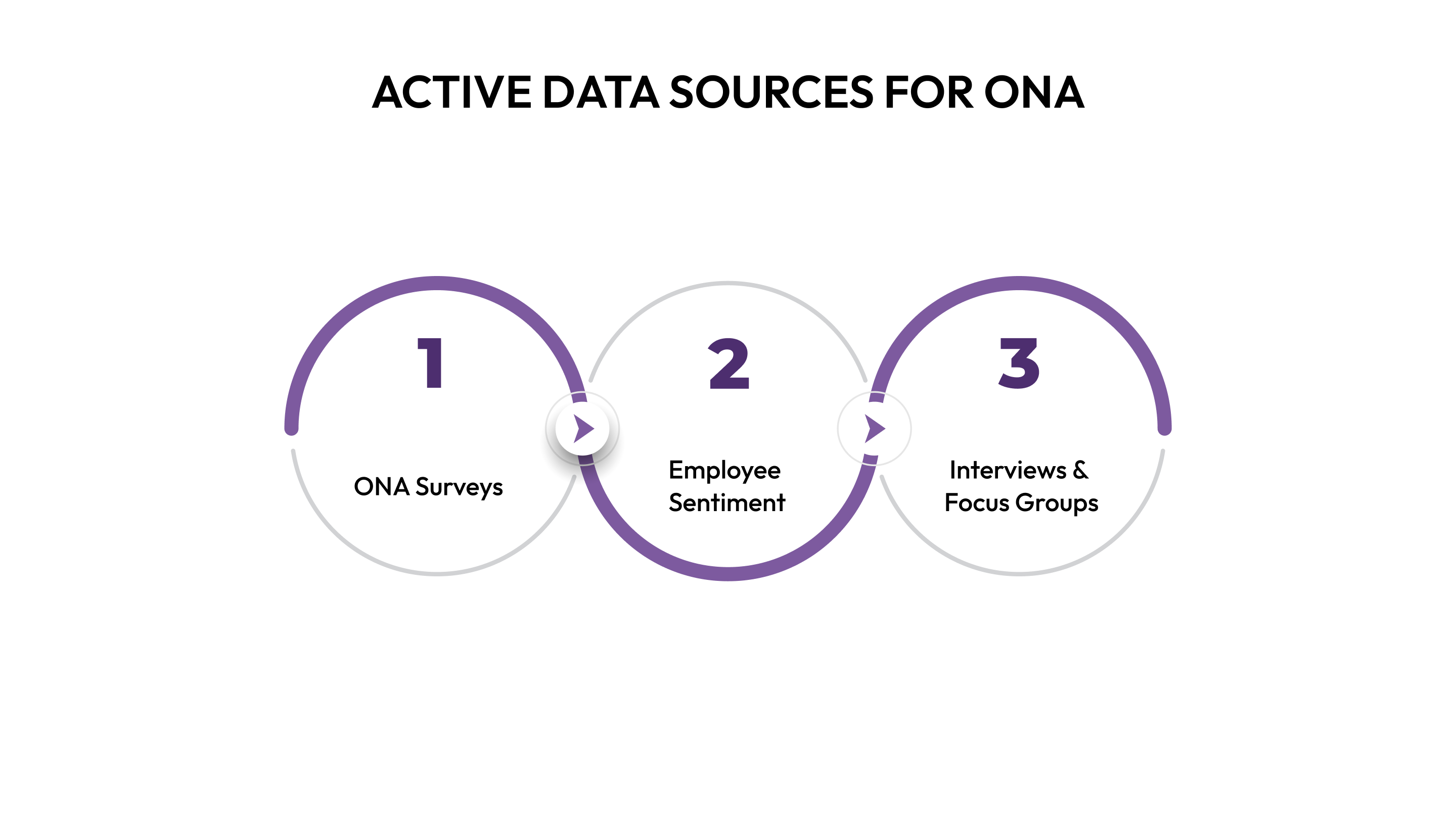
Active data sources require employees to share insights directly, often through surveys or interviews. These sources provide detailed insights into relationships, collaboration, and team engagement. For fast-growing companies with lean HR teams, active data helps provide specific insights that improve communication strategies.
Some common active data sources include:
ONA Surveys:
These surveys ask employees about their interactions and relationships with colleagues, providing key insights into team dynamics and leadership. This data is beneficial for CPOs and People Ops to refine team structures and improve collaboration.
Employee Sentiment Surveys:
These surveys measure trust, satisfaction, and engagement, highlighting areas for improvement in communication and collaboration. Sentiment data is vital for mid-sized companies looking to retain talent in a highly competitive market.
Interviews and Focus Groups:
These methods provide in-depth, qualitative data on employee experiences, revealing issues not captured through surveys. These insights help reduce miscommunication risks between HR, Finance, and leadership.
Active data sources offer precise, firsthand information that highlights areas for improvement in communication and team dynamics. This is especially valuable for organizations with globally distributed or remote-first teams that need to ensure alignment across diverse regions.
Passive Data Sources for ONA
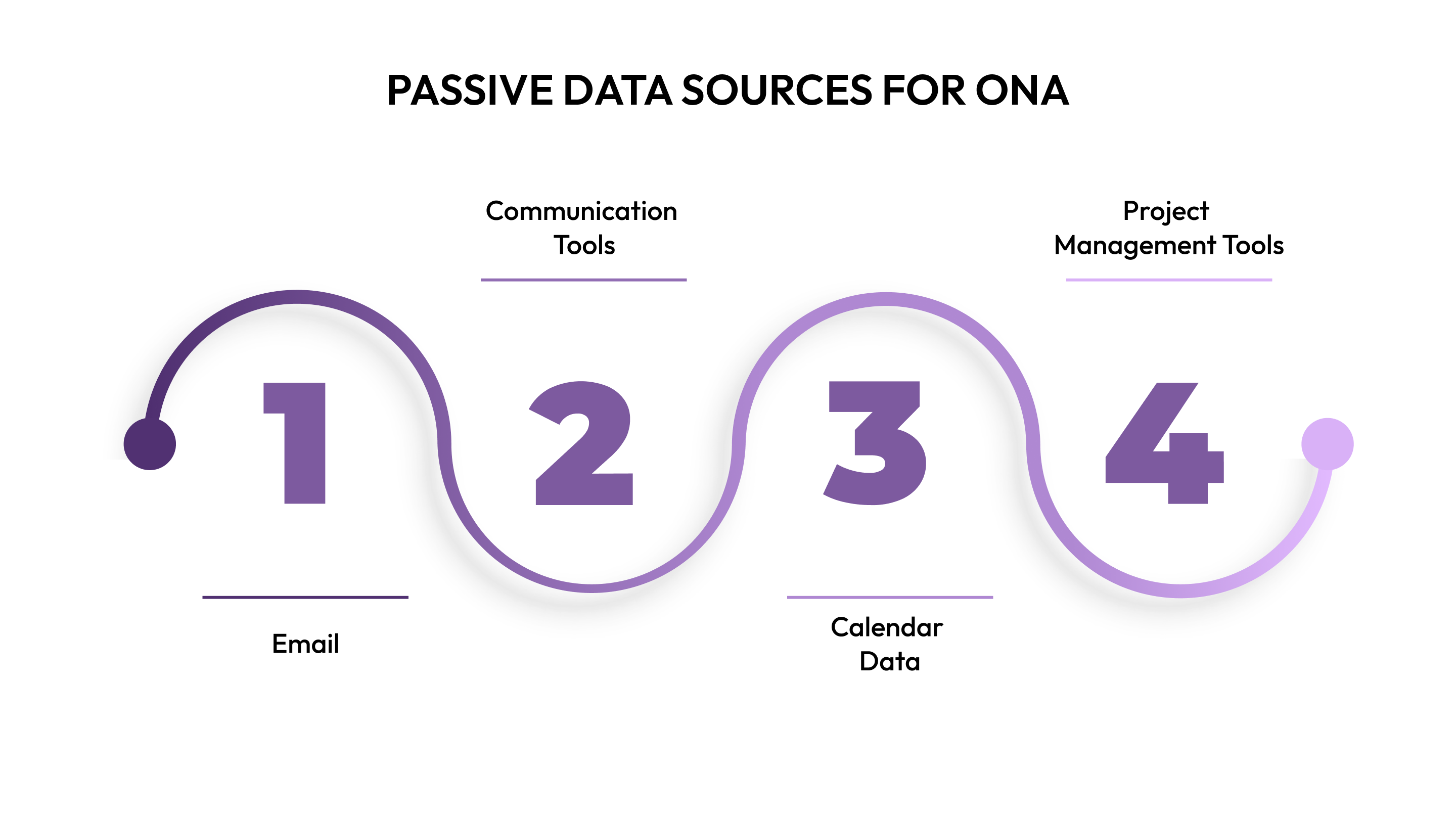
Passive data sources collect information automatically from employee interactions. This data is continuously gathered through communication tools, emails, and calendars, offering real-time insights into how teams collaborate. For recruiting managers, passive data reveals interaction patterns, enabling a better understanding of team needs and collaboration requirements.
Let’s break down some common passive data sources:
Email:
Analyzing email interactions reveals communication patterns, both internally and externally. It helps identify which employees are connecting most often and with whom, a key aspect for organizations with distributed teams.
Communication Tools (Slack, Microsoft Teams):
These platforms offer detailed insights into how teams communicate and collaborate in real-time. The real-time collaboration capabilities are particularly valuable for SaaS, fintech, and e-commerce companies with remote teams.
Calendar Data (Google Calendar, Outlook):
Calendar data reveals meeting frequency, employee availability, and collaboration patterns across teams. This helps identify bottlenecks and scheduling issues, crucial for fast-growing companies scaling headcount quickly.
Project Management Tools (Jira, Asana):
These tools track task assignments and project dependencies, showing collaboration across teams. They help identify where projects are stalling and who is leading initiatives, which is essential for recruiting managers and team leads.
Passive data provides valuable insights into day-to-day interactions and collaboration patterns that are often missed by active data sources. For companies with HR teams of 1-10 people managing compensation operations, passive data is essential for tracking efficiency and making data-driven decisions.
Combining Active and Passive Data Sources
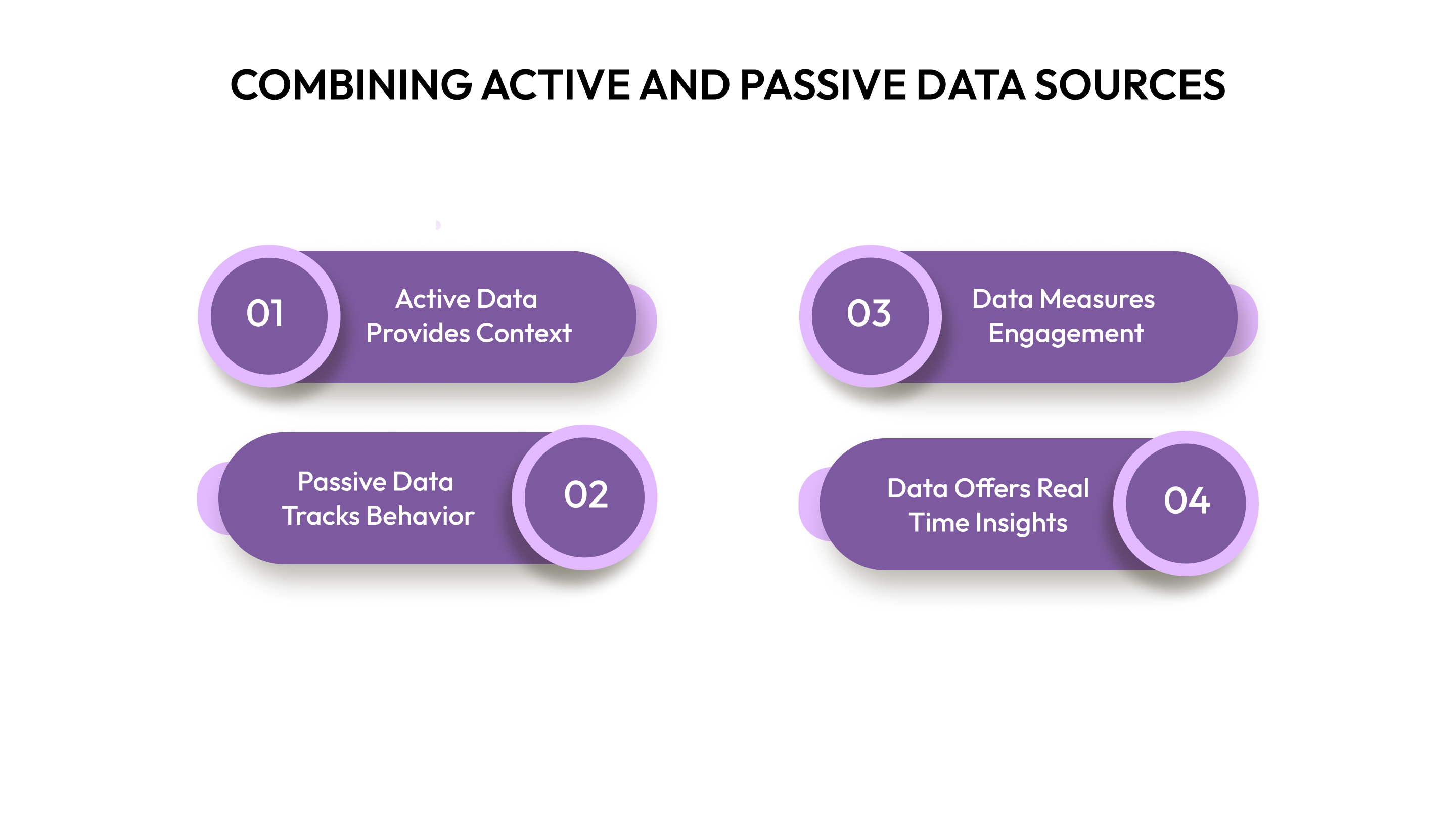
By combining active and passive data, companies can get a clearer picture of their organizational networks. Active data gives context and feedback from employees, while passive data offers real-time, behavior-based insights. For People Ops, HRBPs, and CFOs, combining both data sources ensures better decision-making in compensation, hiring, and resource allocation.
Here’s how they complement each other:
- Active Data Provides Context: It helps explain why specific communication patterns exist, such as why some teams collaborate more than others.
- Passive Data Tracks Behavior: It reveals actual communication patterns, identifying team interactions and bottlenecks that need attention.
- Active Data Measures Engagement: It captures employee sentiment and satisfaction, offering a deeper understanding of the team’s work dynamics.
- Passive Data Offers Real-Time Insights: This data tracks interactions continuously, providing up-to-date information on how teams are working together.
By combining both data types, companies can create a more accurate and actionable map of their organizational networks. This is especially valuable for mid-sized companies scaling rapidly and needing workforce cost predictability.
How ONA Drives Business Outcomes?
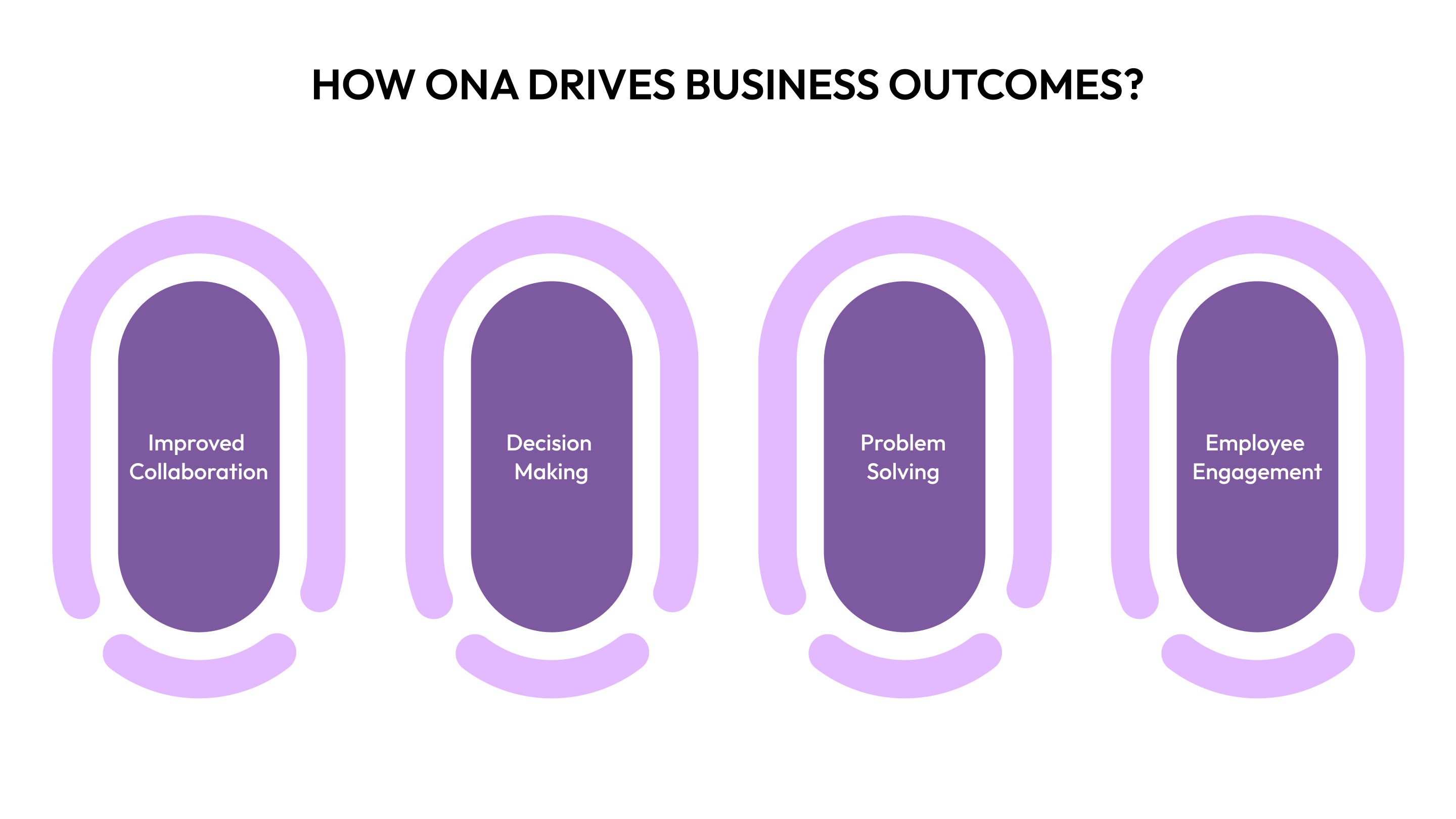
ONA helps organizations improve key business outcomes by revealing how teams communicate and collaborate. Understanding these dynamics allows businesses to optimize workflows, improve decision-making, and enhance overall productivity. This is crucial for budget-sensitive CFOs who need to ensure that employee interactions align with company goals.
Here are a few key business outcomes driven by ONA:
- Improved Collaboration: ONA reveals communication gaps, helping teams work together more effectively and share knowledge. This is important for recruiting managers, as they can see where teams are overburdened and optimize resources.
- Better Decision-Making: ONA provides leaders with a clearer view of team dynamics, allowing them to make more informed decisions about team structures and project assignments.
- Faster Problem-Solving: Identifying key influencers and bottlenecks helps resolve issues more quickly, reducing delays in workflows.
- Stronger Employee Engagement: ONA helps organizations understand employee connections, leading to increased satisfaction and support for team initiatives.
ONA not only identifies problems but also offers solutions for improving collaboration and boosting productivity. For organizations with globally distributed teams, ONA helps ensure that communication flows effectively across borders.
Considerations for Fast-Growth Organizations Using ONA

When implementing ONA in fast-growing organizations, it’s crucial to plan for scalability. As teams expand, organizations need ONA processes that can adapt to their growth while maintaining effectiveness. This is particularly true for mid-sized companies with lean HR teams that manage compensation and headcount planning.
Here are a few considerations for fast-growth companies:
- Scalable Tools: Ensure the ONA tools you choose can handle increased data as your team grows. These tools should support geo-adjusted compensation and help HR teams avoid the risks of disconnected processes.
- Data Privacy Compliance: With sensitive employee data, it is crucial to follow data protection laws, such as GDPR or CCPA, when collecting and analyzing information.
- Resource Management: Select tools that integrate with existing systems to avoid overburdening small HR teams.
- Cultural Sensitivity: As teams grow, be mindful of different work cultures and communication styles. ONA should account for these differences when analyzing collaboration.
By addressing these factors, fast-growing companies can use ONA to stay aligned, productive, and connected as they scale. This is especially important for companies in industries like SaaS, fintech, e-commerce, and professional services that are rapidly expanding.
Also Read: AI-Powered Strategies for Organizational Network Analysis
How CandorIQ Enhances ONA and Workforce Planning?
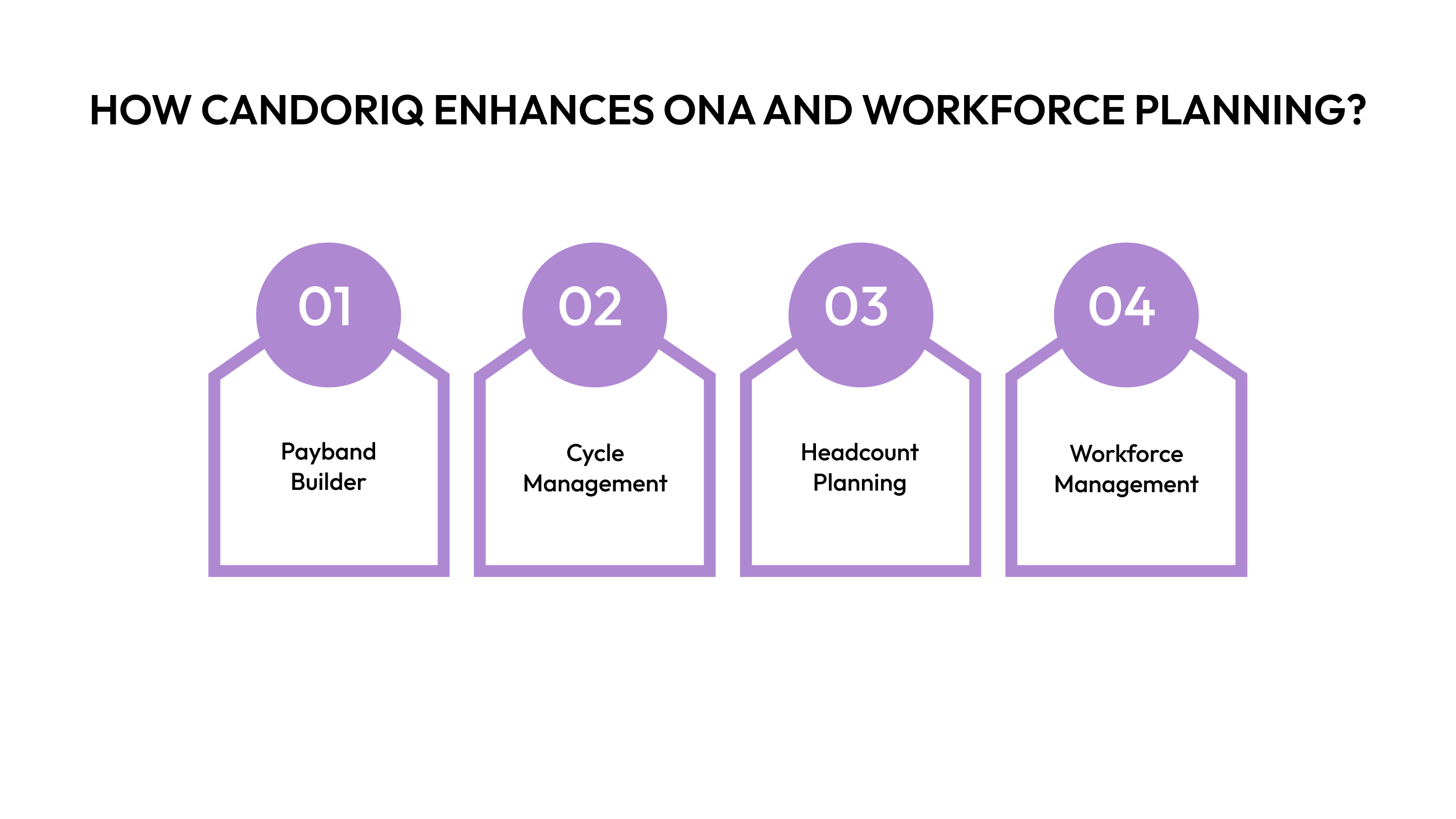
CandorIQ helps simplify compensation management and headcount planning, making it an ideal tool for ONA. By integrating ONA with compensation and workforce data, CandorIQ enables companies to better understand team collaboration and ensure fair pay. This platform is handy for CFOs and HR teams with 1-10 people managing compensation operations.
Here’s how CandorIQ supports ONA efforts:
- Compensation & Payband Builder: It defines clear pay bands by role, department, and location, ensuring fair pay and transparency across the organization. This is critical for globally distributed teams.
- Compensation Cycle Management: Automates merit reviews and bonus approvals, creating a faster and more transparent compensation process, ensuring budget governance.
- Headcount Planning: CandorIQ models headcount scenarios and aligns them with budget goals, helping organizations scale effectively while maintaining financial control.
- Real-Time Workforce Management: Integrates HR and finance data to provide up-to-date insights into workforce health and resource allocation, crucial for fast-growing companies.
CandorIQ combines ONA with compensation and headcount planning for a more connected and efficient workforce. This platform ensures transparency, structure, and equity in compensation decisions.
Conclusion
Organizational Network Analysis helps companies improve collaboration, communication, and decision-making by analyzing how employees interact. By combining active and passive data sources, companies can better understand their internal networks. This deeper understanding leads to improved productivity, engagement, and decision-making.
With the right tools, such as CandorIQ, organizations can integrate ONA with compensation and headcount planning for improved workforce alignment. ONA leads to a more engaged and productive team, especially in fast-growth organizations scaling quickly.
Ready to take the next step? Book a demo with us today to learn how CandorIQ can help your organization grow.
FAQs
Q: What is Organizational Network Analysis (ONA)?
A: ONA is the study of how employees connect, communicate, and collaborate within an organization. It maps both formal and informal relationships, helping companies improve workflows and team dynamics.
Q: How do active and passive data sources work together in ONA?
A: Active data sources involve direct input from employees through surveys, while passive data is gathered from communication tools like emails and calendars. Combining both provides a more complete understanding of team interactions and behaviors.
Q: Why is ONA important for fast-growing companies?
A: For companies scaling quickly, ONA helps identify communication gaps and inefficiencies. It supports data-driven decisions in areas like team collaboration, headcount planning, and employee engagement, which are crucial during rapid growth.
Q: How can CandorIQ enhance ONA efforts?
A: CandorIQ integrates compensation and headcount planning with ONA, helping organizations align their workforce strategies with business goals. It ensures fair pay, transparency, and improved communication between HR, Finance, and leadership.
Q: Can ONA be useful for remote or distributed teams?
A: Yes, ONA is particularly valuable for remote or distributed teams. It helps uncover collaboration patterns, communication silos, and potential inefficiencies across different time zones and locations, ensuring alignment despite geographical distance.


